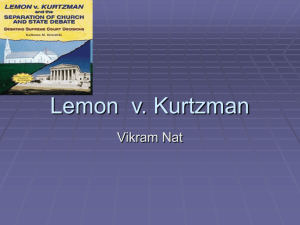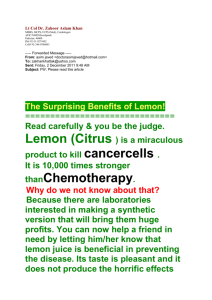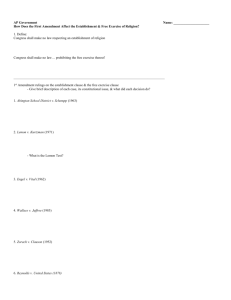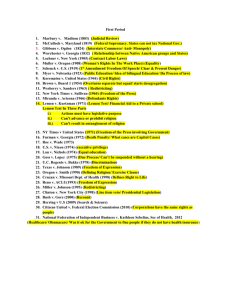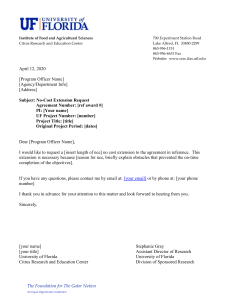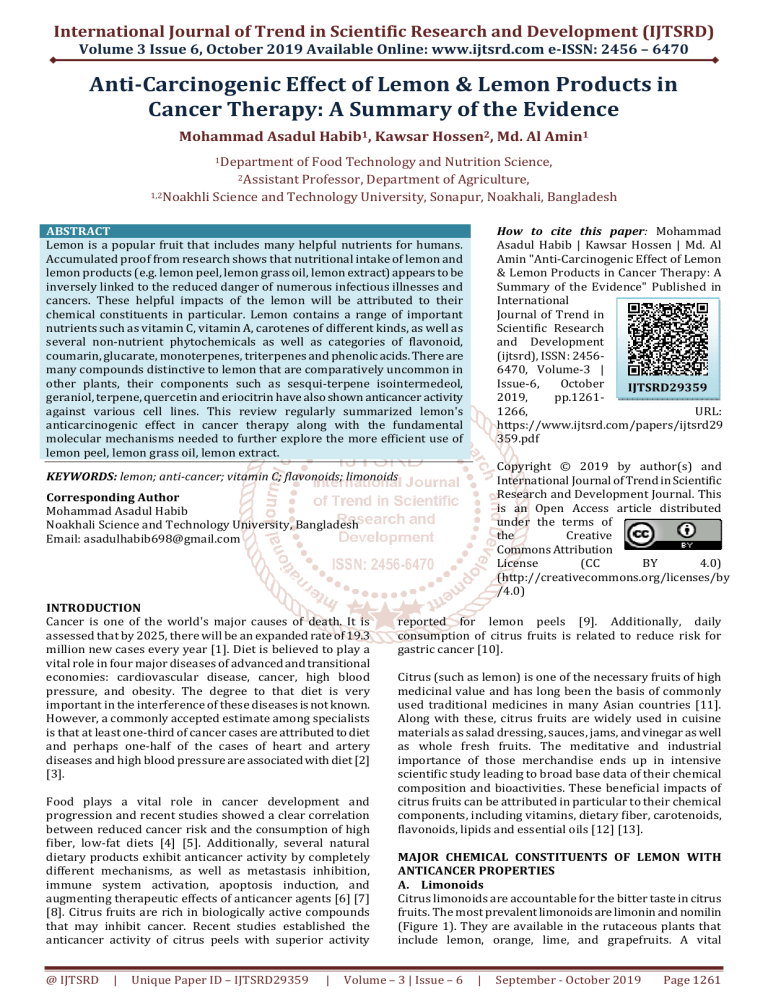
International Journal of Trend in Scientific Research and Development (IJTSRD)
Volume 3 Issue 6, October 2019 Available Online: www.ijtsrd.com e-ISSN: 2456 – 6470
Anti-Carcinogenic Effect of Lemon & Lemon Products in
Cancer Therapy: A Summary of the Evidence
Mohammad Asadul Habib1, Kawsar Hossen2, Md. Al Amin1
1Department
of Food Technology and Nutrition Science,
Professor, Department of Agriculture,
1,2Noakhli Science and Technology University, Sonapur, Noakhali, Bangladesh
2Assistant
ABSTRACT
Lemon is a popular fruit that includes many helpful nutrients for humans.
Accumulated proof from research shows that nutritional intake of lemon and
lemon products (e.g. lemon peel, lemon grass oil, lemon extract) appears to be
inversely linked to the reduced danger of numerous infectious illnesses and
cancers. These helpful impacts of the lemon will be attributed to their
chemical constituents in particular. Lemon contains a range of important
nutrients such as vitamin C, vitamin A, carotenes of different kinds, as well as
several non-nutrient phytochemicals as well as categories of flavonoid,
coumarin, glucarate, monoterpenes, triterpenes and phenolic acids. There are
many compounds distinctive to lemon that are comparatively uncommon in
other plants, their components such as sesqui-terpene isointermedeol,
geraniol, terpene, quercetin and eriocitrin have also shown anticancer activity
against various cell lines. This review regularly summarized lemon's
anticarcinogenic effect in cancer therapy along with the fundamental
molecular mechanisms needed to further explore the more efficient use of
lemon peel, lemon grass oil, lemon extract.
How to cite this paper: Mohammad
Asadul Habib | Kawsar Hossen | Md. Al
Amin "Anti-Carcinogenic Effect of Lemon
& Lemon Products in Cancer Therapy: A
Summary of the Evidence" Published in
International
Journal of Trend in
Scientific Research
and Development
(ijtsrd), ISSN: 24566470, Volume-3 |
Issue-6,
October
IJTSRD29359
2019,
pp.12611266,
URL:
https://www.ijtsrd.com/papers/ijtsrd29
359.pdf
Copyright © 2019 by author(s) and
International Journal of Trend in Scientific
Research and Development Journal. This
is an Open Access article distributed
under the terms of
the
Creative
Commons Attribution
License
(CC
BY
4.0)
(http://creativecommons.org/licenses/by
/4.0)
KEYWORDS: lemon; anti-cancer; vitamin C; flavonoids; limonoids
Corresponding Author
Mohammad Asadul Habib
Noakhali Science and Technology University, Bangladesh
Email: asadulhabib698@gmail.com
INTRODUCTION
Cancer is one of the world's major causes of death. It is
assessed that by 2025, there will be an expanded rate of 19.3
million new cases every year [1]. Diet is believed to play a
vital role in four major diseases of advanced and transitional
economies: cardiovascular disease, cancer, high blood
pressure, and obesity. The degree to that diet is very
important in the interference of these diseases is not known.
However, a commonly accepted estimate among specialists
is that at least one-third of cancer cases are attributed to diet
and perhaps one-half of the cases of heart and artery
diseases and high blood pressure are associated with diet [2]
[3].
Food plays a vital role in cancer development and
progression and recent studies showed a clear correlation
between reduced cancer risk and the consumption of high
fiber, low-fat diets [4] [5]. Additionally, several natural
dietary products exhibit anticancer activity by completely
different mechanisms, as well as metastasis inhibition,
immune system activation, apoptosis induction, and
augmenting therapeutic effects of anticancer agents [6] [7]
[8]. Citrus fruits are rich in biologically active compounds
that may inhibit cancer. Recent studies established the
anticancer activity of citrus peels with superior activity
@ IJTSRD
|
Unique Paper ID – IJTSRD29359
|
reported for lemon peels [9]. Additionally, daily
consumption of citrus fruits is related to reduce risk for
gastric cancer [10].
Citrus (such as lemon) is one of the necessary fruits of high
medicinal value and has long been the basis of commonly
used traditional medicines in many Asian countries [11].
Along with these, citrus fruits are widely used in cuisine
materials as salad dressing, sauces, jams, and vinegar as well
as whole fresh fruits. The meditative and industrial
importance of those merchandise ends up in intensive
scientific study leading to broad base data of their chemical
composition and bioactivities. These beneficial impacts of
citrus fruits can be attributed in particular to their chemical
components, including vitamins, dietary fiber, carotenoids,
flavonoids, lipids and essential oils [12] [13].
MAJOR CHEMICAL CONSTITUENTS OF LEMON WITH
ANTICANCER PROPERTIES
A. Limonoids
Citrus limonoids are accountable for the bitter taste in citrus
fruits. The most prevalent limonoids are limonin and nomilin
(Figure 1). They are available in the rutaceous plants that
include lemon, orange, lime, and grapefruits. A vital
Volume – 3 | Issue – 6
|
September - October 2019
Page 1261
International Journal of Trend in Scientific Research and Development (IJTSRD) @ www.ijtsrd.com eISSN: 2456-6470
characteristic of this class of compound is a substituted furan
moiety. It has been determined by animal studies that citrus
limonoids and derivatives have certain biological activities
that may be used as chemo preventive agents for cancer. [14]
[15].
Vitamin C can also behave as a coantioxidant by regenerating
α-tocopherol (vitamin E) from the α-tocopheroxyl radical
generated via scavenging of lipid-soluble radicals. This is a
potentially important significant because in vitro
experiments have shown that α-tocopherol can behave as a
pro-oxidant in the absence of co-antioxidants such as
vitamin C [20] [21] [22] [14] [15] [16].
Figure 1: Chemical structure of (a) limonin and (b)
nomilin, the major bioactive limonoids.
Glutathione S-transferase (GST) is a major detoxifying
enzyme system that catalyzes the conjugation of glutathione
with electrophiles that induce activated carcinogens. The
glutathione conjugates are usually less reactive and more
water-soluble, and hence, facilitate excretion. A rise in GST
activity caused by a substance is, therefore, an elevation in
the mechanism that protects against the noxious effects of
xenobiotics, including carcinogens. It has been discovered
that many chemicals that are GST enhancers inhibit
chemically induced carcinogenesis [15] [16].
B. Flavonoids
Flavonoid structure is based on a 2-phenyl-benzo[a]pyrane
or flavane nucleus. This nucleus is defined by having a
system of two benzene rings (A and B), which are connected
by an oxygen-containing pyrane ring (C). The flavonoids
(including compounds such as flavones, isoflavones,
flavonols and flavanes) are a group of low molecular weight
polyphenolic compounds that are widely distributed in
plants oxidative processes contributing to immediate tissue
damage that occurs during heart attack or stroke (Figure 2)
[17] [18] [19].
Figure 2: Chemical structures of sub-classes of
flavonoids.
C. Vitamin C (ascorbic acid)
Vitamin C is an important water-soluble antioxidant (Figure3) in biological fluids. It promptly scavenges reactive
nitrogen and oxygen species, for example, hydroperoxyl
radicals, superoxide, singlet oxygen, aqueous peroxyl
radicals, peroxynitrite, ozone, nitrogen dioxide, nitroxide
radicals, and hydrochlorous acid, thereby essentially
protecting other biomolecules from oxidative damage.
@ IJTSRD
|
Unique Paper ID – IJTSRD29359
|
Figure 3: Chemical structure of ascorbic acid
(antioxidant).
Vitamin C may protect against cancer through several
mechanisms, in addition to inhibiting DNA oxidation. One
potential mechanism is chemoprotection against mutagenic
compounds such as nitrosamines, which can be formed by
the reaction of nitrite or nitrate (common in food and
cigarette smoke) with amines and amides.26,27 Vitamin C
prevents the reaction of nitrites with amines and amides that
form potent carcinogenic nitrosamines within the digestive
tract and prevents oxidation of specific chemicals to their
active carcinogenic forms [18] [19] [23].
D. Essential oils
Citrus (lemon) essential oil comes from the fruits and leaves
of various citrus species. It may be either steam processed or
cold-pressed to produce the essential oil. Fruits and
vegetables contain an abundance of terpenoids, phenolic
substances and different natural anti-oxidants that are
associated with protection from and treatment of chronic
diseases like cancer and disorder. It has been shown that
terpenoids in the category of citrus compounds are useful in
maintaining and improving health, including several
subclasses such as monoterpenes terpene, carvone, myrcene,
and carveol), sesquiterpenes β-cubebene, β-elemene, βcaryophyllene, π-cadinene, diterpenes retinoids, oleanic acid,
and ursolic acid). These subclasses have a range of action
mechanisms that influence oxidative stress, carcinogenesis,
and cardiovascular diseases, among others [24].
E. Coumarins
Coumarins possess anti-carcinogenic activities partially by
inducing carcinogen detoxifying enzymes. By causing
carcinogenic detoxifying enzymes, naturally occurring
coumarins have anti-carcinogenic operations in part. Citrus
peels comprise a range of coumarins that possess
mevalonate derived side chains with numerous oxidation
levels. Citrus peels contain a variety of coumarins that
possess mevalonate derived side chains with numerous
oxidation levels. Researchers have demonstrated that orally
administered citrus coumarin, limettin, imperatorin and
isopimpinellin blocked 7, 12-dimethylbenz anthracene
DMBA) DNA adduct formation in mouse mammary glands
(Prince, et al., 2006). Interestingly, citrus oils, specifically,
contain extensive amounts of both simple as well as
Volume – 3 | Issue – 6
|
September - October 2019
Page 1262
International Journal of Trend in Scientific Research and Development (IJTSRD) @ www.ijtsrd.com eISSN: 2456-6470
furanocoumarins. three known citrus coumarins particularly
bergamottin, oxypeucedanin and 5-[6́, 7́-dihydroxy-3́, 7́dimethyl-2-octenyl) oxy] psoralen, have been isolated from
Citrus hystrix DC as inhibitors of both lipopolysaccharide
LPS) and interferon- IFN-γ)-induced nitric oxide NO)
generation in RAW 264.7 cells. Consequently, suppression of
the iNOS-induced NO generation in excess amounts is
currently accepted wide as a new paradigm for the
chemoprevention of cancer [25].
Figure 4: Chemical structure of coumarins
F. Citrus fatty acids
Citrus fruits (lemon) are well-known to be an abundant
resource of compounds that might help prevent lifestylerelated diseases like diabetes, high pressure, and cancer.
Many fatty acids were reported from the seed and peel of
citrus species [26]. Antioxidant activity of the citrus extract
is additionally assessed by measuring free fatty acid content
since unsaturated fatty acids play a very important role to
regulate the various sorts of cancers. The constituents of
total lipids and neutral lipid categories, i.e., hydrocarbons,
wax esters, sterol esters, triacylglycerols, free fatty acids, 1,3diacylglycerols, 1,2-diacylglycerols, free sterols, alcohols, and
monoacylglycerols of 3 species of Citrus particularly C.
sinensis, C. paradisi, C. aurantium were investigated by thin
layer and gas natural process. Palmitic, oleic and linoleic
acids were the main elements in all the lipids and lipid
categories studied [27].
ANTICANCER ROLE OF LEMON & LEMON PRODUCTS
A. Lemon
Numerous epidemiological findings and investigations have
demonstrated that consumption of vegetables and fruits
decreased the incidence of carcinogenesis [28] [29].
Therefore, it is feasible to find novel drugs in dietary
phytochemicals to interfere with the development of cancer
[30]. Lemon (Citrus Limon) belongs to citrus fruits. It
contains various polyphenols (mainly flavonoids) which
possess positive health effects, for instance, the amelioration
of behavioral impairment, anti-oxidation, and cancer
prevention [31] [32] [33] [34] [35]. Eriocitrin (eriodictyol 7rutinoside) is such a flavonoid extracted from lemon. Minato
et al. reported that eriocitrin could protect diabetic rats from
oxidative stress, suggesting that it may serve as an
antioxidative agent in vivo [36]. Hiramitsu et al. found that
eriocitrin suppressed exercise-induced oxidative damage in
rat liver as well [37]. In addition, Wang et al. showed that
eriocitrin could ameliorate diet-induced hepatic steatosis
[38]. Interestingly, the structure of eriocitrin is very similar
to hesperidin, which was reported to exhibit antitumor
effects on various cancers such as liver cancer and ovary
cancer [34]
[38]. Thus, we speculated that eriocitrin may also have
anticancer activity and examined whether eriocitrin could
inhibit the proliferation of hepatocellular carcinoma cells.
@ IJTSRD
|
Unique Paper ID – IJTSRD29359
|
B. Lemon (Citrus lemon L.) peel extract
Lemon is a vital healthful plant of the family Rutaceae. It is
harvested primarily for its alkaloids, which are having
anticancer activities and the antibacterial potential in crude
extracts of various components (leaves, stem, viz., root and
flower) of lemon against clinically significant microorganism
strains has been reported [39]. The depart Citrus fruits
(Citrus lemon L.) could be a wealthy supply of flavonoid
glycosides, coumarins, β and γ- sitosterol, glycosides and
volatile oils [40]. Several polymethoxylated flavones have
many necessary bioactivities that are very rare in other
plants [41]. Citrus flavonoids have a wide range of biological
activity including antibacterial, antidiabetic, antifungal,
anticancer and antiviral activities [42] [43]. Flavonoids can
perform as direct antioxidants and radical scavengers, and
have the capability to modulate protein activities and inhibit
cell proliferation [44]. In plants, they seem to play a
defensive role against invasive pathogens, including
bacterium, fungi, and viruses [45].
C. Lemon grass oil
Several natural products are nowadays used as effective
anticancer agents. Within the last 20 years, the search for
novel anticancer agents from natural sources has witnessed
an impressive increase of interest. The genus Cymbopogon
(family Gramineae) has several species of grasses that grow
in tropical and semitropical regions around the world from
mountains to grasslands to arid zones [46]. These plants
produce essential oils with pleasant aromas in their leaves.
Five species yield the three oils of main commercial
importance: lemongrass from Cymbopogon citratus of
Malaysian origin (West Indian lemongrass) and Cymbopogon
flexuosus (East Indian lemongrass) from India, Sri Lanka,
Burma, and Thailand; palmarosa oil from Cymbopogon
martinii; citronella oil from Cymbopogon nardus (Sri Lanka),
and Cymbopogon winterianus (Java). Cymbopogon flexuosus
(also referred to as East India or Cochin lemongrass) is a
perennial, multicut aromatic grass that yields a necessary oil
used in perfumery and pharmaceutical industries and
vitamin A [47]. Cymbopogon flexuosus oil helps with stressrelated disorders, and has shown to own antifungal and
antimicrobial properties [48]. The chemical composition of
the oil has additionally been reported [49]. The various
constituents (%) present in the oil from lemongrass variety
of C. flexuosus like geraniol (20.08), geranyl acetate (12.20),
α-bisabolol (8.42) and isointermedeol (24.97) are one by one
reported for his or her neoplastic cell toxicity [49] [50].The
volatile oil from a lemongrass kind of Cymbopogon flexuosus
(CFO) and its major chemical constituent sesqui-terpene
isointermedeol (ISO) were investigated for their ability to
induce apoptosis in human leukemia HL-60 cells because
deregulation of apoptosis is the hallmark of cancer cells. CFO
and ISO suppressed cell proliferation with IC50 of ~30 and
20 μg/ml, respectively [49].
D. Lemon extract
Lemon extract contains many biologically active
phytochemicals including D-limonene. This compound is a
monocyclic monoterpene and represents a major component
of citrus oils [51]. Inductions of apoptosis and angiogenesis
inhibition are the main mechanisms of action of limonene
against cancer [52]. In the present study, high concentrations
of limonene were recognized in the combination as well as
lemon extract. The observed anticancer effect of the lemon
extract could be explained by the presence of high
Volume – 3 | Issue – 6
|
September - October 2019
Page 1263
International Journal of Trend in Scientific Research and Development (IJTSRD) @ www.ijtsrd.com eISSN: 2456-6470
concentrations of limonene in lemon extract. Phytochemical
analysis revealed the presence of phenolic compounds,
flavonoids, and alkaloids in lemon aqueous extract [53].
These results are consistent with the previous study that
showed the presence of phenols, alkaloids, flavonoids, and
terpenoids in lemon juice. A dose-dependent inhibition of
cell growth and proliferation was observed after treatment
of EMT6/P cells with serial dilutions of lemon aqueous
extract (30–100 mg/mL) with IC50 value of 89.32 mg/mL
[54].
CONCLUSION
Taken all together, a considerable number of wellestablished lines of evidence have confirmed that citrus
fruits (e.g. lemon, lemon peel, lemon grass oil, lemon extract)
exhibit a remarkable spectrum of efficacious biological
activities, particularly in antitumori genesis. As mentioned
earlier, the d-limonene found in citrus fruits has multiple
health advantages and one of them includes cancer
prevention. Lemons also contain a flavonoid, which,
according to a recent study, has strong cancer-preventing
properties. Lemon peel, lemon extract and lemon grass oil
also contain high amounts of flavonoid, monoterpenes,
triterpenes, sesquiterpene isointermedeol, which are plant
compounds found to prevent tumors cell. Lemons, lemon
peel, lemon grass oil, the lemon extract have to possess great
bioavailability which consequently attracts researchers to
perform scientific studies for effective disease prevention
and treatment.
AUTHOR’S CONTRIBUTION
Mohammad Asadul Habib carried out the studies,
participated in the sequence alignment, performed in the
analysis of the findings and drafted the manuscript. Md. Al
Amin in the design of the study, sequence alignment &
drafted the manuscript. Kawsar Hossen; Assistant Professor,
Noakhali Science & Technology University conceived of the
study, and participated in its design and coordination and
helped to draft the manuscript. All authors read and
approved the final manuscript.
REFERENCES
[1] Block KI, Gyllenhaal C, Lowe L, Amedei A, Amin AR,
Amin A, Aquilano K, Arbiser J, Arreola A, Arzumanyan
A, Ashraf SS. Designing a broad-spectrum integrative
approach for cancer prevention and treatment.
InSeminars in cancer biology 2015 Dec 1 (Vol. 35, pp.
S276-S304). Academic Press
[2] Goldberg I. Functional foods: designer foods,
pharmafoods, nutraceuticals. Springer Science &
Business Media; 2012 Dec 6.
[3] Milner JA. Reducing the Risk of Cancer [w:] Functional
Food, pod red. I. Goldberg.
[4] Zhou Y, Li Y, Zhou T, Zheng J, Li S, Li HB. Dietary natural
products for prevention and treatment of liver cancer.
Nutrients. 2016 Mar;8(3):156.
[5] Turati F, Rossi M, Pelucchi C, Levi F, La Vecchia C. Fruit
and vegetables and cancer risk: a review of southern
European studies. British Journal of Nutrition. 2015
Apr;113(S2):S102-10.
[6] J Thoppil R, Bhatia D, F Barnes K, Haznagy-Radnai E,
Hohmann J, S Darvesh A, Bishayee A. Black currant
anthocyanins abrogate oxidative stress through Nrf2@ IJTSRD
|
Unique Paper ID – IJTSRD29359
|
mediated antioxidant mechanisms in a rat model of
hepatocellular carcinoma. Current cancer drug targets.
2012 Nov 1; 12(9):1244-57.
[7] Yu MH, Gwon Im H, Gyu Lee S, Kim DI, Jeong Seo H, Lee
IS. Inhibitory effect of immature plum on PMA-induced
MMP-9 expression in human hepatocellular carcinoma.
Natural product research. 2009 May 20; 23(8):704-18.
[8] Ren M, Ye L, Hao X, Ren Z, Ren S, Xu K, Li J.
Polysaccharides from Tricholoma matsutake and
Lentinus edodes enhance 5-fluorouracil-mediated H22
cell growth inhibition. Journal of Traditional Chinese
Medicine. 2014 Jun 1;34(3):309-16.
[9] Alshatwi AA, Shafi G, Hasan TN, Al-Hazzani AA, Alsaif
MA, Alfawaz MA, Lei KY, Munshi A. Apoptosis-mediated
inhibition of human breast cancer cell proliferation by
lemon citrus extract. Asian Pac J Cancer Prev. 2011 Jan
1;12(6):1-555.
[10] Bae JM, Kim EH. Dietary intakes of citrus fruit and risk
of gastric cancer incidence: an adaptive metaanalysis of
cohort studies. Epidemiology and health. 2016;38.
[11] Kubo M, Matsuda H, Tomohiro N, Harima S. Historical
and pharmalogical study of Citrus hassaku.
Yakushigaku zasshi. 2005;40(1):47-51.
[12] Patil JR, Jayaprakasha GK, Murthy KC, Tichy SE, Chetti
MB, Patil BS. Apoptosis-mediated proliferation
inhibition of human colon cancer cells by volatile
principles of Citrus aurantifolia. Food Chemistry. 2009
Jun 15;114(4):1351-8.
[13] Hardin A, Crandall PG, Stankus T. Essential oils and
antioxidants derived from citrus by-products in food
protection and medicine: an introduction and review of
recent literature. Journal of Agricultural & Food
Information. 2010 Apr 14;11(2):99-122.
[14] Miller EG, Gonzales-Sanders AP, Couvillon AM, Binnie
WH, Hasegawa S, Lam LK. Citrus limonoids as
inhibitors of oral carcinogenesis. Food technology
(USA). 1994.
[15] Lam LK. Citrus limonoid reduction of chemicallyinduced tumorigenesis. Food. Technol.. 1994;48:104-8
[16] Brody T. Digestion and absorption of carbohydrates, u
Nutritional Biochemistry (T. Brody, urednik).
[17] Aruoma OI. Free radicals, oxidative stress, and
antioxidants in human health and disease. Journal of
the American oil chemists' society. 1998
Feb;75(2):199-212.
[18] Carr AC, Frei B. Toward a new recommended dietary
allowance for vitamin C based on antioxidant and
health effects in humans. The American journal of
clinical nutrition. 1999 Jun 1;69(6):1086-107.
[19] Silalahi J. Free radicals and antioxidant vitamins in
degenerative diseases. J Indon Med Assoc. 2001;51:1621.
[20] Gillman MW. Enjoy your fruits and vegetables
[21] Zino S, Skeaff M, Williams S, Mann J. Randomised
controlled trial of effect of fruit and vegetable
consumption on plasma concentrations of lipids and
antioxidants. Bmj. 1997 Jun 21;314(7097):1787.
Volume – 3 | Issue – 6
|
September - October 2019
Page 1264
International Journal of Trend in Scientific Research and Development (IJTSRD) @ www.ijtsrd.com eISSN: 2456-6470
[22] Burri BJ. Beta-carotene and human health: a review of
current research. Nutrition Research. 1997 Mar
1;17(3):547-80.
Eriocitrin ameliorates diet-induced hepatic steatosis
with activation of mitochondrial biogenesis. Scientific
reports. 2014 Jan 15;4:3708.
[23] Rouseff RL, Nagy S. Health and nutritional benefits of
citrus fruit components. Food technology (USA). 1994.
[38] Wang Y, Yu H, Zhang J, Gao J, Ge X, Lou G. Hesperidin
inhibits HeLa cell proliferation through apoptosis
mediated by endoplasmic reticulum stress pathways
and cell cycle arrest. BMC cancer. 2015 Dec;15(1):682.
[24] Wagner KH, Elmadfa I. Biological relevance of
terpenoids. Annals of Nutrition and metabolism.
2003;47(3-4):95-106.
[25] Murakami A, Gao G, Kim OK, Omura M, Yano M, Ito C,
Furukawa H, Jiwajinda S, Koshimizu K, Ohigashi H.
Identification of coumarins from the fruit of Citrus
hystrix DC as inhibitors of nitric oxide generation in
mouse macrophage RAW 264.7 cells. Journal of
agricultural and food chemistry. 1999 Jan
18;47(1):333-9.
[26] Saidani M, Dhifi W, Marzouk B. Lipid evaluation of
some Tunisian Citrus seeds. Journal of Food Lipids.
2004 Sep;11(3):242-50.
[27] Waheed A, Mahmud S, Saleem M, Ahmad T. Fatty acid
composition of neutral lipid: Classes of Citrus seed oil.
Journal of Saudi Chemical Society. 2009 Oct
1;13(3):269-72.
[28] Key TJ. Fruit and vegetables and cancer risk. British
journal of cancer. 2011 Jan;104(1):6-11.
[29] Reddy LA, Odhav B, Bhoola KD. Natural products for
cancer prevention: a global perspective. Pharmacology
& therapeutics. 2003 Jul 1;99(1):1-3.
[30] Lee KW, Bode AM, Dong Z. Molecular targets of
phytochemicals for cancer prevention. Nature Reviews
Cancer. 2011 Mar;11(3):211.
[31] González-Molina E, Domínguez-Perles R, Moreno DA,
García-Viguera C. Natural bioactive compounds of
Citrus limon for food and health. Journal of
pharmaceutical and biomedical analysis. 2010 Jan
20;51(2):327-45.
[32] Li C, Zug C, Qu H, Schluesener H, Zhang Z. Hesperidin
ameliorates
behavioral
impairments
and
neuropathology of transgenic APP/PS1 mice.
Behavioural brain research. 2015 Mar 15;281:32-42.
[33] Bacanlı M, Başaran AA, Başaran N. The antioxidant and
antigenotoxic properties of citrus phenolics limonene
and naringin. Food and chemical Toxicology. 2015 Jul
1;81:160-70.
[34] Banjerdpongchai R, Wudtiwai B, Khaw-on P,
Rachakhom W, Duangnil N, Kongtawelert P. Hesperidin
from Citrus seed induces human hepatocellular
carcinoma HepG2 cell apoptosis via both mitochondrial
and death receptor pathways. Tumor Biology. 2016 Jan
1;37(1):227-37.
[35] Miyake Y, Yamamoto K, Tsujihara N, Osawa T.
Protective effects of lemon flavonoids on oxidative
stress in diabetic rats. Lipids. 1998 Jul 1;33(7):689.
[39] Kawaii S, Tomono Y, Katase E, Ogawa K, Yano M,
Koizumi M, Ito C, Furukawa H. Quantitative study of
flavonoids in leaves of Citrus plants. Journal of
agricultural and food chemistry. 2000 Sep
18;48(9):3865-71.
[40] Shahnah SM, Ali S, Ansari H, Bagri P. New sequiterpene
derivative from fruit peel of citrus limon (Linn) Burn. F.
Sci. Pharm. 2007;75:165-70.
[41] Ahmad MM, Iqbal Z, Anjum FM, Sultan JI. Genetic
variability to essential oil composition in four citrus
fruit species. Pakistan Journal of Botany. 2006
Feb;38(2):319.
[42] Burt S. Essential oils: their antibacterial properties and
potential applications in foods—a review. International
journal of food microbiology. 2004 Aug 1;94(3):223-53.
[43] Ortuño A, Báidez A, Gómez P, Arcas MC, Porras I,
García-Lidón A, Del Río JA. Citrus paradisi and Citrus
sinensis flavonoids: Their influence in the defence
mechanism against Penicillium digitatum. Food
Chemistry. 2006 Jan 1;98(2):351-8.
[44] Duthie G, Crozier A. Plant-derived phenolic
antioxidants. Current opinion in lipidology. 2000 Feb
1;11(1):43-7.
[45] Sohn HY, Son KH, Kwon CS, Kwon GS, Kang SS.
Antimicrobial and cytotoxic activity of 18 prenylated
flavonoids isolated from medicinal plants: Morus alba
L., Morus mongolica Schneider, Broussnetia papyrifera
(L.) Vent, Sophora flavescens Ait and Echinosophora
koreensis Nakai. Phytomedicine. 2004 Nov 25;11(78):666-72.
[46] Kumar S, Dwivedi S, Kukreja AK, Sharma JR, Bagchi GD.
Cymbopogon: The aromatic grass monograph.
Lucknow, India: Central Institute of Medicinal and
Aromatic Plants; 2000.
[47] LEWINSOHN E, DUDAI N, TADMOR Y, KATZIR I, Ravid
UZ, Putievsky EL, JOEL DM. Histochemical localization
of citral accumulation in lemongrass leaves
(Cymbopogon citratus (DC.) Stapf., Poaceae). Annals of
Botany. 1998 Jan 1;81(1):35-9.
[48] Chao SC, Young DG, Oberg CJ. Screening for inhibitory
activity of essential oils on selected bacteria, fungi and
viruses. Journal of essential oil research. 2000 Sep
1;12(5):639-49.
[36] Minato KI, Miyake Y, Fukumoto S, Yamamoto K, Kato Y,
Shimomura Y, Osawa T. Lemon flavonoid, eriocitrin,
suppresses exercise-induced oxidative damage in rat
liver. Life sciences. 2003 Feb 21;72(14):1609-16.
[49] Kumar A, Malik F, Bhushan S, Sethi VK, Shahi AK,
Taneja SC, Qazi GN, Singh J. An essential oil and its
major constituent isointermedeol induce apoptosis by
increased expression of mitochondrial cytochrome c
and apical death receptors in human leukaemia HL-60
cells. Chemico-biological interactions. 2008 Feb 15;
171(3):332-47.
[37] Hiramitsu M, Shimada Y, Kuroyanagi J, Inoue T, Katagiri
T, Zang L, Nishimura Y, Nishimura N, Tanaka T.
[50] Cavalieri E, Mariotto S, Fabrizi C, de Prati AC, Gottardo
R, Leone S, Berra LV, Lauro GM, Ciampa AR, Suzuki H.
@ IJTSRD
|
Unique Paper ID – IJTSRD29359
|
Volume – 3 | Issue – 6
|
September - October 2019
Page 1265
International Journal of Trend in Scientific Research and Development (IJTSRD) @ www.ijtsrd.com eISSN: 2456-6470
α-Bisabolol, a nontoxic natural compound, strongly
induces apoptosis in glioma cells. Biochemical and
biophysical research communications. 2004 Mar 12;
315(3):589-94.
[51] Lu XG, Zhan LB, Feng BA, Qu MY, Yu LH, Xie JH.
Inhibition of growth and metastasis of human gastric
cancer implanted in nude mice by d-limonene. World
Journal of Gastroenterology: WJG. 2004 Jul 15;
10(14):2140.
[52] Njoku VI, Evbuomwan BO. Analysis and comparative
study of essential oil extracted from Nigerian orange,
@ IJTSRD
|
Unique Paper ID – IJTSRD29359
|
lemon and lime peels. Greener Journal of Chemical
Science and Technology. 2014;1(1):6- 14.
[53] Oikeh EI, Omoregie ES, Oviasogie FE, Oriakhi K.
Phytochemical, antimicrobial, and antioxidant activities
of different citrus juice concentrates. Food science &
nutrition. 2016 Jan;4(1):103-9.
[54] Talib WH. Consumption of garlic and lemon aqueous
extracts combination reduces tumor burden by
angiogenesis inhibition, apoptosis induction, and
immune system modulation. Nutrition. 2017 Nov 1;
43:89-97.
Volume – 3 | Issue – 6
|
September - October 2019
Page 1266

